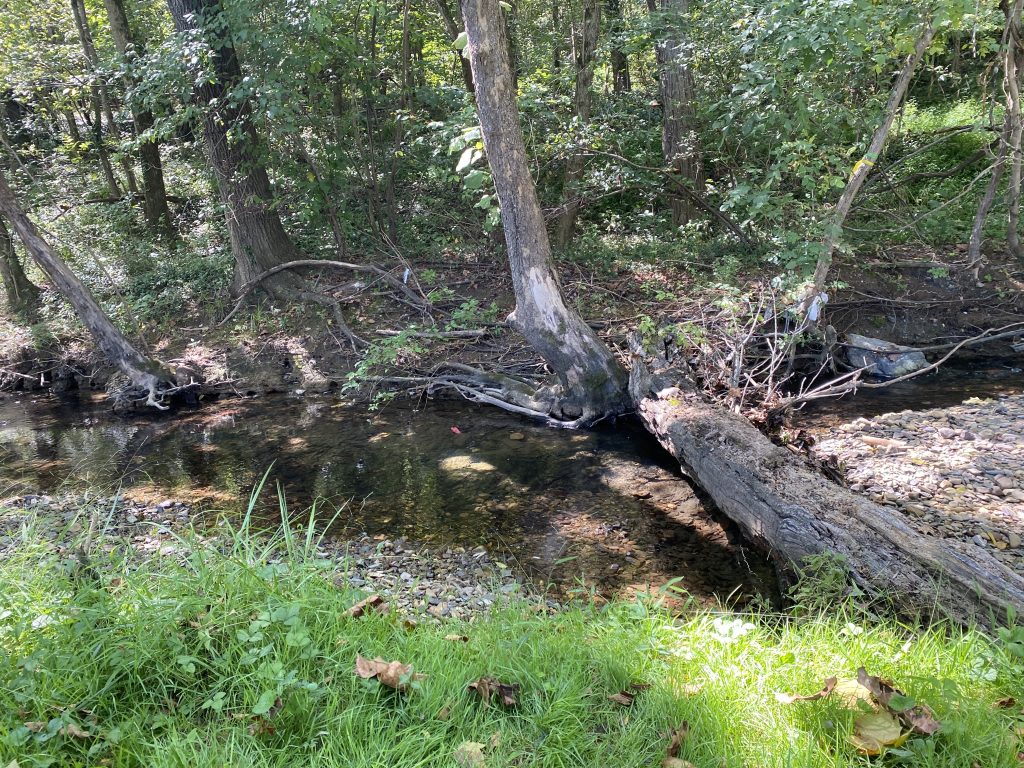
Front View of my Sit-Spot
Rebekah’s Private Cove: Sit-Spot Blog #2
How happy I was to return to my sit spot for the second time! That was after I found it; it was yet again concealed by a small wall of trees.
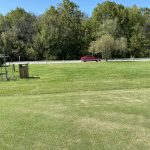
Walking to my Spot
To be more exact, my sit-spot is directly across from the middle of the soccer field, down over the sloping hill, past a small line of trees, and in front of the decayed log on a small bank of grass. My front view is of Carvin’s Creek, and on the lower east bank, the water is surrounded by a thick blanket of rocks. In the picture, it is right about where the red car and willow tree are! Hopefully, I will be able to find my spot more easily next time I come back to my cove.
When I began to observe at 12:19 pm, I was surprised that the first sense calling me was not sight, but instead smell. There were many pleasant aromas that day, but a particular one caught my nose; the smell of cedarwood. I was unsure whether or not it was truly cedar and I wondered where it would have been coming from. Regardless, I enjoyed the faint odor as it reminded me of my hope chest at home. In addition, I also smelled the water with a taint of algae and the crisp, fresh air. While sitting and looking around, I first noticed a dead cicada upside down in the grass and picked it up to examine, but sadly the wing was torn off, so I decided to examine the wing solely instead. Although dead, I found the wing to be beautiful with its intricate lines.
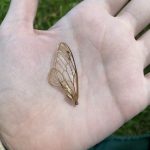
Cicada Wing
It was mainly clear, but also slightly a milky color from moisture reaching internally. Also, I noticed the grass to be much higher, yet still soft. I could also feel the sun warming my skin, despite the slight chill in the air. As for the sounds I heard, it was definitely filled with more man-made sounds such as lawnmowers and cars passing by, as the wind was not as prevalent. The sound of the creek was more defined, and I continued to hear the bubbling and gurgling of the water throughout the duration of my observations. There was also less white noise from the cicadas and crickets, as well as little song from the birds. I did happen to hear a crow once!
Upon examining the three objects I will be following this semester, little had changed since my last visit. First, I checked on the Ash tree, and noticed very few changes.
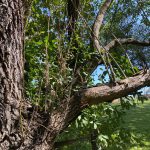
Ash Tree with Sprouts
The trunk was still knobby and twisted, and still had sprouts with green leaves towards the bottom half. However, I noticed that some of the sprouts had turned brown and yellow, lost their leaves, and simply looked like vertical sticks. Next, I checked on the roots with moss and mushrooms, and discovered that most of the mushrooms had disappeared! The remaining ones had turned a brown-yellow color, and the ones that were gone had left a dark shadow of where they had used to be.
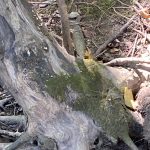
Roots with Moss and Mushrooms
Also, there was a lot of moss left, although it had turned a darker shadow of green, with tints of brown. I believe the roots were more suspended over the water than last time, and wonder if this was the source of the changes due to less water access. Lastly, I examined the decayed log, and I believed this had the most visible differences. There was much leaf mass on the right side of the log, most likely due to the rain washing debris down the risen creek, and it simply had gotten stuck when the water levels fell.
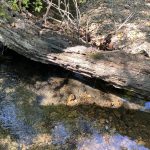
Decayed Log
During my initial visit, I had noticed the holes in the log probably due to termites, but I believe during this visit there was an increase of holes compared to my last visit. Also, the log looks as if it is bowing about three-fourths of the way across from me, and I am curious to know whether or not it will snap during the semester!
I was very excited to get up and walk around my sit spot, as I knew there were many new things to observe that I would not have had the chance to just sitting! I walked around my sit-spot once already at the end of my first visit, but did not overly observe my surroundings, nor did I include them in my journal.
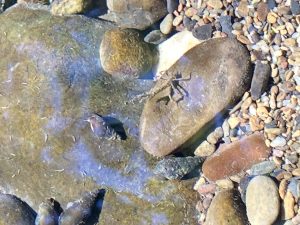
Damselfly on Rock
I was first drawn to the water and went to see if I could find any organisms in the current, similar to the ones we had searched for in our stream lab. Immediately, I spotted a gilled snail, followed by another, followed by a few dozen more! I knew if I had not gotten up, I would not have spotted them, as they are extremely tiny, and can blend into the rocks. Then I spotted another water macroinvertebrate, which I believed to be a damselfly. It was perched on a rock, and almost seemed to be bathing in the sun! As I got closer and tried to take pictures underwater, it did not like my disturbances and crawled away. This small photoshoot led me to realize the water was colder than last time.
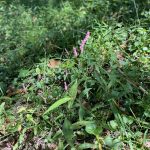
Lady’s Thumb
As I continued walking, I also realized the rock bank was much higher than my previous visit, which perhaps was built up from the rain. After I got out of the water, I trailed along the grassy area and noted that the ground was more frequently covered with sycamore leaves in various shades of green, yellow, and brown. My most exciting find among the grassy area was the bloom of pink buds that I identified as Lady’s Thumb. It was exclusively sprouted along the tree line, and was bright pink! By walking around my sit-spot, I learned how moving a couple of feet around can change your entire perspective and make you see things you had not seen before!
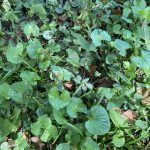
Garlic Mustard Leaves
Throughout my sit-spot, I spotted three organisms that had adaptations that made life sustainable. In the beginning, I thought it would be hard to find adaptations, but then I realized I was surrounded by multitudes of characteristics organisms have adapted to. First, I spotted two male robins flitting easily from branch to branch on a Winterberry tree with bright red berries above the creek. It made me think about how amazing it is that they have adapted their feet to be able to hook onto small limbs without falling off. Upon further research, I learned robins have three toes pointing forwards and one toe pointing backward, as well as leg joints that can hyperextend and lock them into place.
Without this adaptation, robins would not be able to use this tree as an easy feeding source. Next, I noticed an abundance of garlic mustard leaves that were heart-shaped with large rounded irregular teeth. These leaves were broadly expanded, and I made this connection as they were trying to gather as much light as they could for photosynthesis. This adaptation went in hand with their leaves following the sun’s path! I found it cool that the leaves were all facing the same direction that the sun was radiating towards. Lastly, my favorite adaptation was that of the gilled snails. These snails were able to cling to the surface of the rocks, unbothered by the water current or any debris floating along. Also, another adaptation of these snails is their shells, which protect them from predators and can even prevent them from drying out if they are out of water for an extended period. Without these observations, I would not have thought twice about these organism’s adaptations! I left my sit-spot at 1:27 pm.
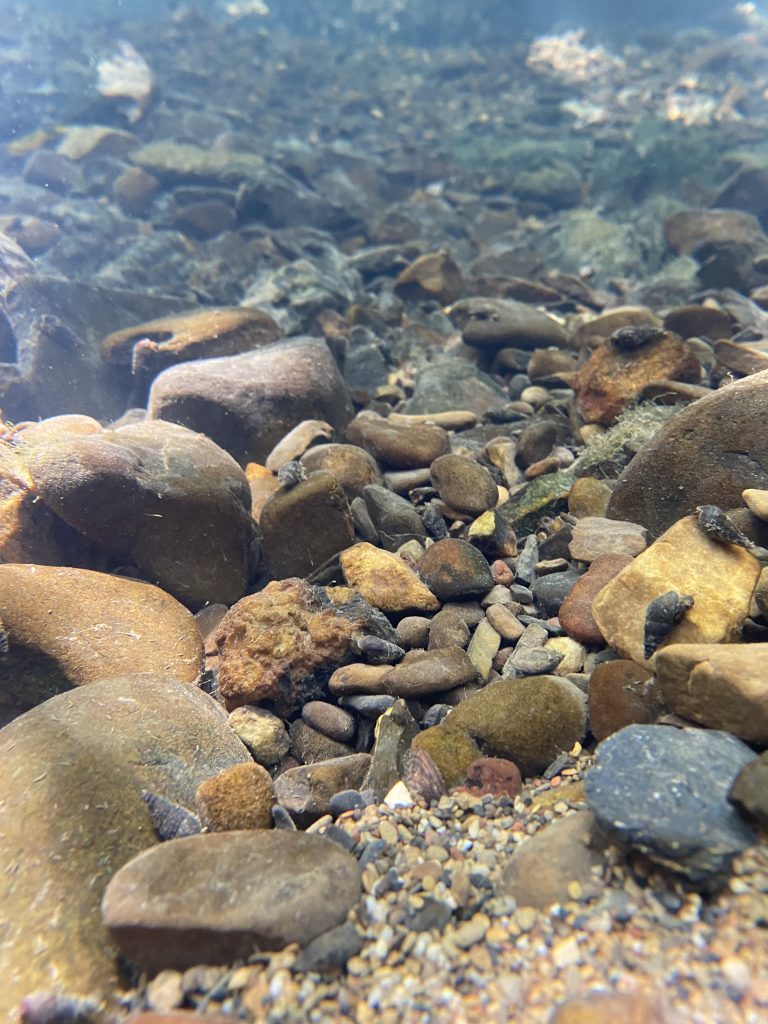
Look Closely- There are many Gilled Snails with their Protective Shells!

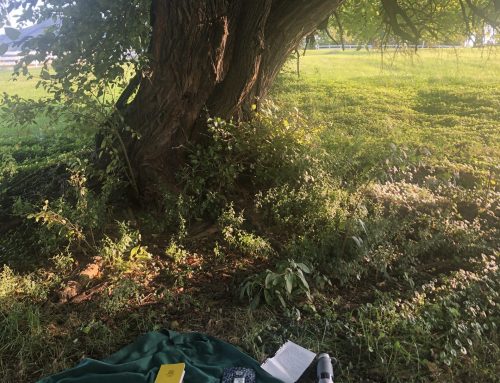
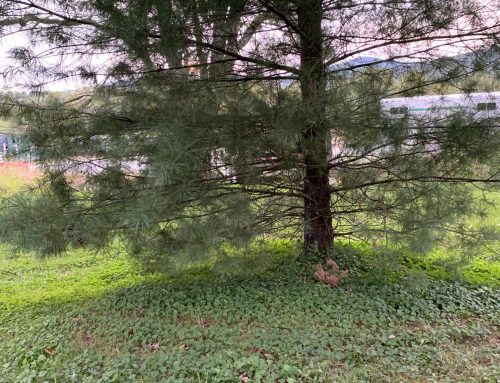
I loved your quip about robins using the tree as a feeding source
I did not know that the colouration of the dead cicada wing was caused by moisture inside! It was really cool to read your blog, you know how to describe the smell of the water and it makes sense. Your post was very informative and helpful and I also enjoyed the last photo in your blog.
The photo of the snails is very cool! Their various adaptations are very cool, and from experience, I’ve seen certain snails control air intake into their shells to allow them to sink or float, though I’m not sure if these particular snails do it. Watching them cling to rocks in fast flowing water is definitely a cool sight! I also enjoy all of your photos.